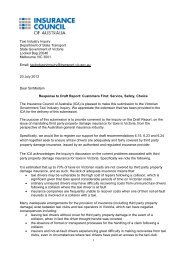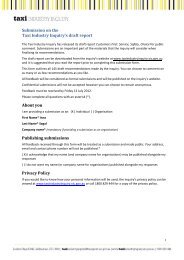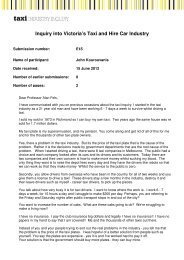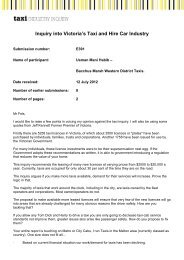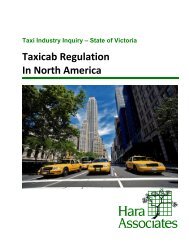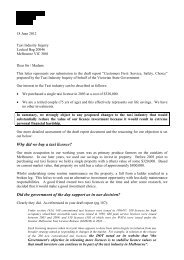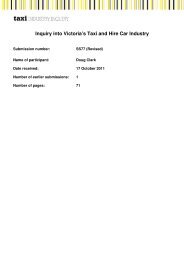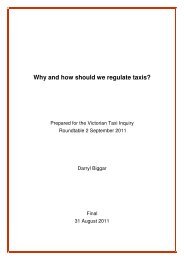Part D â Understanding and improving industry performance (PDF ...
Part D â Understanding and improving industry performance (PDF ...
Part D â Understanding and improving industry performance (PDF ...
Create successful ePaper yourself
Turn your PDF publications into a flip-book with our unique Google optimized e-Paper software.
1. Is too much entry likely, <strong>and</strong> does Victoria already<br />
have too many taxis?<br />
The first argument in favour of quantitative restrictions<br />
is that there will simply be ‘too much entry’. The inquiry<br />
received numerous submissions <strong>and</strong> comments from<br />
licence owners, taxi operators <strong>and</strong> drivers that there is<br />
no need for more taxi licences in Melbourne or elsewhere<br />
in Victoria. It would be easy to dismiss this as ‘<strong>industry</strong><br />
pleading’, but there is evidence to suggest this is more<br />
than a theoretical possibility in taxi markets.<br />
One reason why too much entry might occur comes from<br />
price regulation. For example, prior to the removal of<br />
entry controls, fares may be regulated taking into account<br />
the rental (or assignment) value of a taxi licence. This<br />
may occur explicitly or implicitly. Then if entry controls<br />
are removed, but there is no consequent downward<br />
adjustment in fares either through competition or fare<br />
regulation, there will be too many new entrants into the<br />
<strong>industry</strong> <strong>and</strong> they will all operate inefficiently. As noted by<br />
Dr Darryl Biggar in a paper prepared for the inquiry:<br />
…in those markets in which price competition is<br />
absent (such as the market for rank-<strong>and</strong>-hail taxi<br />
services), <strong>and</strong> where entry is uncontrolled, if regulated<br />
fares are set above an efficient level then it is likely<br />
that there will be ‘too much’ entry. In this sense,<br />
setting regulated tariffs too high might result in a form<br />
of ‘over supply’. However, this is not a market failure<br />
in its own right – rather it is a symptom of the failure<br />
to adequately or effectively correct another market<br />
failure (in the price mechanism). 42<br />
There is some evidence that this is consistent with the<br />
experiences of Irel<strong>and</strong> <strong>and</strong> the Netherl<strong>and</strong>s during the<br />
2000s. 43 In these markets, entry controls were removed<br />
but fares did not fall to compensate for the lower cost<br />
structure of operators. In Irel<strong>and</strong>, where existing fare<br />
controls were maintained, supply increased greatly as<br />
did dem<strong>and</strong>. In the Netherl<strong>and</strong>s, where the maximum<br />
fare was increased, supply increased as did the level of<br />
fares <strong>and</strong> the overall effect on dem<strong>and</strong> was mixed. 44 In<br />
both cases, new entrants were presumably attracted by<br />
the high fares <strong>and</strong> overall vehicle productivity suffered by<br />
more than would have been the case if fares were also<br />
lowered. However, the inquiry notes that it is not obvious<br />
that consumers were worse off as a result: this ultimately<br />
depends on the effect of the additional supply on<br />
consumer dem<strong>and</strong>. If many more trips were undertaken<br />
at the higher price, then the gains from the (inefficient)<br />
entry may well have outweighed the costs.<br />
To better underst<strong>and</strong> the effect of entry restrictions <strong>and</strong><br />
whether more supply is likely to stimulate dem<strong>and</strong>, the<br />
inquiry has undertaken some specific surveying to gauge<br />
the importance of service availability to consumers. This<br />
is discussed further in chapter 19.<br />
The inquiry also examined evidence on the number of taxis<br />
<strong>and</strong> hire cars in Melbourne <strong>and</strong> Victoria compared with<br />
other jurisdictions. This gives some insight into whether<br />
different licensing regimes have a significant impact on the<br />
quantities of taxi <strong>and</strong> hire car services consumed.<br />
Simple comparisons can be made across jurisdictions<br />
about the number of taxis <strong>and</strong> hire cars. However, this<br />
does not tell the complete story. The number of vehicles<br />
required to service the dem<strong>and</strong> for taxis <strong>and</strong> hire cars<br />
depends on many different factors. Some measures<br />
that are sometimes put forward as being relevant are<br />
described in Table 10.1.<br />
Table 10.1 Factors affecting the ability of taxis <strong>and</strong> hire cars<br />
to service dem<strong>and</strong><br />
Factor<br />
The greater the population of<br />
the area served<br />
The higher the population<br />
density of the area served<br />
The better the quality of<br />
public transport options<br />
The higher the numbers of<br />
tourists (airport journeys)<br />
The more intensively vehicles<br />
are used (such as double<br />
<strong>and</strong> triple shifting)<br />
The higher the levels of<br />
private vehicle ownership<br />
The higher the average<br />
income<br />
Supports fewer or<br />
more taxis?<br />
More<br />
More<br />
More (taxis are complements)<br />
Fewer (taxis are substitutes)<br />
More<br />
Fewer<br />
Fewer<br />
More<br />
A careful distinction also needs to be made between<br />
what drives dem<strong>and</strong> for taxi services <strong>and</strong> what is relevant<br />
for determining how many taxis might be required to<br />
fulfil actual dem<strong>and</strong>. A higher population within an area<br />
would seem to support more taxi services, as this should<br />
be closely linked to dem<strong>and</strong>. On the other h<strong>and</strong>, vehicle<br />
utilisation has nothing to do with dem<strong>and</strong> but more<br />
intensive use of vehicles (such as double or triple shifting<br />
of a vehicle) would reduce the need for more vehicles to<br />
meet dem<strong>and</strong>.<br />
42 Biggar, Darryl (2011), Why <strong>and</strong> how should we regulate taxis? – Paper<br />
Prepared for the Victorian Taxi Industry Inquiry, Melbourne, p.16<br />
43 See for example Ba<strong>and</strong>ers, A. <strong>and</strong> Canoy, M. (2010), Op. Cit., p.3<br />
44 The number of trips was reported to have fallen while the number of<br />
passenger kilometers rose, implying higher average trip lengths<br />
192





